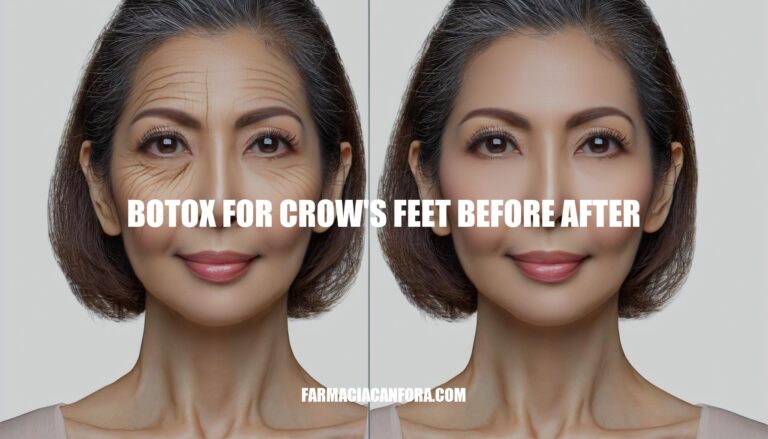Crow’s feet are the fine lines that appear at the outer corners of the eyes, often becoming more pronounced with age due to repeated facial expressions and environmental factors. Many people seek Botox treatments to reduce the appearance of these lines, aiming for a smoother, more youthful look. Understanding the before and after effects of Botox is crucial, as it helps set realistic expectations and showcases the potential improvements in skin appearance.
What are Crow’s Feet?
Crow’s feet are fine lines and wrinkles that appear at the outer corners of the eyes. They often extend towards the temples or upper cheeks.
Appearance
- Fine lines: Initially, they appear as small, fine lines.
- Wrinkles: Over time, these lines deepen into more pronounced wrinkles.
Development
Crow’s feet develop due to a combination of factors:
- Aging: Natural loss of collagen and elastin, which are proteins that keep skin firm and elastic.
- Facial expressions: Repeated movements like smiling, squinting, and frowning cause the skin around the eyes to crease.
- Sun exposure: Ultraviolet (UV) light accelerates the breakdown of collagen.
- Smoking: Reduces collagen and elastin, and deprives the skin of oxygen and nutrients.
- Genetics: Some people are more predisposed to developing wrinkles due to their genetic makeup.
How Botox Works for Crow’s Feet
Botox, derived from botulinum toxin type A, works by blocking nerve signals that instruct muscles to contract. When injected into the muscles around the eyes, specifically the orbicularis oculi muscle, Botox temporarily relaxes these muscles. This relaxation prevents the repetitive muscle contractions that cause crow’s feet, thereby smoothing the overlying skin and reducing the appearance of wrinkles. The effects typically become noticeable within a few days and can last for several months.
Before Treatment: What to Expect
Here are the key steps and considerations before undergoing Botox treatment for crow’s feet:
Consultations
- Initial Consultation: Schedule a consultation with a qualified dermatologist or plastic surgeon. Discuss your medical history, any allergies, and your aesthetic goals.
- Assessment: The doctor will assess the severity of your crow’s feet and determine the appropriate dosage and injection sites.
Pre-Treatment Care
- Avoid Blood Thinners: Stop taking blood-thinning medications (like aspirin or ibuprofen) at least a week before the treatment to reduce the risk of bruising.
- No Alcohol: Avoid alcohol for 24 hours before the procedure.
- Skin Care: Cleanse your face thoroughly and avoid applying any makeup or skincare products on the day of the treatment.
Potential Side Effects
- Common Side Effects: Mild swelling, redness, and bruising at the injection site.
- Less Common Side Effects: Headache, dry eyes, or drooping eyelids.
- Allergic Reactions: Rare but possible; inform your doctor immediately if you experience any unusual symptoms.
Additional Considerations
- Post-Treatment Care: Follow your doctor’s advice on post-treatment care, such as avoiding strenuous activities and not rubbing the treated area for at least 24 hours.
- Follow-Up: Schedule a follow-up appointment to assess the results and discuss any concerns.
After Treatment: Immediate Effects
Right after Botox treatment for crow’s feet, patients can expect the following:
Immediate Changes in Appearance
- Smoother Skin: The skin around the eyes will start to appear smoother as the muscles relax.
- Reduced Fine Lines: Fine lines and wrinkles around the eyes will diminish.
Common Side Effects
- Redness and Swelling: Mild redness and swelling at the injection sites are common.
- Bruising: Some patients may experience minor bruising.
- Tingling or Numbness: A slight tingling or numbness around the treated area can occur.
Timeline
- Initial Effects: Noticeable improvements can be seen within a few days.
- Full Results: The full effect is typically visible within two weeks.
Long-Term Results: Before and After Comparison
Before and After Results of Botox Treatment for Crow’s Feet
Before Treatment:
- Appearance: Crow’s feet, or lateral canthal lines, are visible as fine lines radiating from the corners of the eyes. These lines are more pronounced when smiling or squinting due to repeated muscle contractions.
- Skin Condition: The skin around the eyes may appear less firm and elastic, contributing to a tired or aged look.
After Treatment:
- Immediate Improvements: Within a few days post-treatment, the muscles around the eyes begin to relax, reducing the appearance of crow’s feet. The skin appears smoother and more youthful.
- Full Results: By day 30, significant improvements are typically observed. Studies show that a majority of patients experience a noticeable reduction in the depth and visibility of crow’s feet. The skin around the eyes looks tighter and rejuvenated.
Long-Term Benefits:
- Sustained Results: The effects of Botox can last between three to four months. Regular treatments can maintain the smooth appearance and prevent the deepening of wrinkles over time.
- Preventive Benefits: Botox not only treats existing lines but also helps prevent new ones from forming by reducing muscle contractions that cause wrinkles.
- Natural Look: Advanced techniques allow for subtle enhancements, maintaining natural facial expressions while achieving a more youthful appearance.
Botox Treatment for Crow’s Feet and Wrinkles
Botox is an effective treatment for reducing the appearance of crow’s feet, fine lines, and wrinkles around the eyes. It works by temporarily relaxing the muscles that cause these lines to form.
Before undergoing Botox treatment, it’s essential to consult with a qualified dermatologist or plastic surgeon to discuss your medical history, aesthetic goals, and determine the appropriate dosage and injection sites.
Potential side effects include mild swelling, redness, and bruising at the injection site, as well as less common side effects like headache, dry eyes, or drooping eyelids.
After treatment, patients can expect immediate improvements in skin appearance, with noticeable results within a few days and full effects visible within two weeks. Regular treatments can maintain sustained results and prevent new wrinkles from forming, while advanced techniques allow for subtle enhancements that maintain natural facial expressions.


